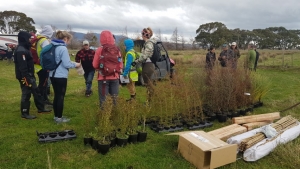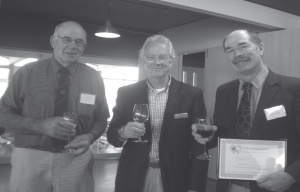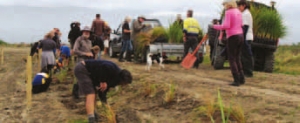Displaying items by tag: Planting
Planting day at Wairio
A planting day for Victoria University students and Ducks Unlimited members at Wairio came with a few more mod cons than usual, thanks to DU President Ross Cottle.
He arrived in his motorhome with Big Red, the side-by-side in tow, which meant hot cups of tea and sausages for lunch and the easy delivery via SxS of the plants to the planting site.
There was a good turnout as students from Victoria University’s School of Biological Sciences led by Stephen Hartley, director, Greater Wellington Regional Council and DOC representatives, DU members and others all chipped to help with the day’s work.
About 300 specimen trees – kahikatea, tōtara, swamp maire and cabbage trees – were bought with a $2000 grant from the Department of Conservation.
Many hands make light work, and by the end of the day, the trees were in place as in-fill in Stage 3 of the wetland, the university’s “classroom in a wetland”, among the nursery trees planted five years ago.
Riparian plan helps BoP farmer
purchased the property on his 21st birthday) and now his eldest son, Allen, manages operations.
The farm was originally rundown with leaky fences, rudimentary sheep yards, a basic woolshed and no cattle yards. About a quarter of the 300ha was covered in fern and manuka, and plenty of gorse.
Today the sheep and dairy grazing station has been heralded as a sustainable success. The former Meat & Wool Board monitor farm, and supreme winner of the Bay of Plenty Ballance Farm Environment Awards, has benefited from technology and environmental practices.
Jim said measures had been put in place on the farm located in the lower Kaimai Ranges, to preserve the fauna, flora and Mangakaiwhiria Stream that meanders through the property. Thousands of trees were planted, most waterways fenced and land around the stream
perseverance and hard work.
“When you retire land from grazing, you can have real problems. First, you need to have a substantial fence that is stock proof, and it’s advisable to run a hot wire at shoulder height to deter cattle from reaching through.”
Noxious animals and weeds were other problems, and although the gorse had been beaten any spraying done had to be judicious as there was the risk of killing replacement plantings. Regional council natural resources operations manager Warwick Murray said the council has been working for decades on land and waterway management.
Since 2009, 569 farmers have taken advantage of regional council assistance to improve water quality and farm productivity, he said. The riparian programme uptake was increasing year on year.
“This response has been terrific but we’d love to have more landowners on board,” Warwick said.
The Western Bay of Plenty District Council also provides funding for fencing in certain circumstances. Figures show stock has been excluded from 87 percent of the stream length within the Tauranga Harbour catchment, 83 percent of Ohiwa Harbour catchment streams and Nukuhou and Waiotahi Rivers, and 93 percent of stream margins in the Rotorua Lakes.
Classroom in a Wetland
Victoria University’s classroom in a wetland!
Five years ago, Victoria University Wellington students planted a swathe of nursery trees in the Wairio Wetland.
This landmark wetland habitat was created in the late 1980s by Ducks Unlimited in Collaboration with the Department of Conservation (DOC).
Last week the Victoria University biodiversity team were back. Stephen Hartley and his team were armed with over 300 specimen trees (Kahikatea, Totara, Tawaki (or Swamp) Maire & Cabbage)- sourced thanks to a $2000 grant from DOC - to continue their comparative research into cost effective restoration processes by adding these trees as infill planting.
The cold but enthusiastic University team were supported by members of Ducks Unlimited and DOC.
Arbor Day planting a tradition
Seven classes from Waikanae and Kapanui Schools were ‘eager beavers’ on Friday June 6, when around 1700 plants were planted on the west margin of the northern pond at the Pharazyn Reserve wetland near Waikanae.
The two local schools have been involved for some years now and the planting is a popular activity with the students.
This latest planting complements work done in previous years in the programme to re-habilitate a wetland margin around the former oxidation ponds for Waikanae that were de-commissioned in 2002.
To date approximately half of the margins have been planted over the last seven to eight years. The earlier plantings are doing extremely well with a number of the students proudly pointing out where they had planted in previous years.
Planting day at Ruffit Lodge
Fine weather was ideal for a ‘planting’ day at Ruffit Lodge (east of Woodville) mid May, with a few neighbours, friends and family mucking in to help.
160 trees were planted, with most getting the Don Bell ‘Growtector’ treatment. “This is the last section of our waterway to be fenced and planted. Just a few more flaxes and trees to go.” To encourage helpers Julie Candy offered soup and buns for lunch.
Wairio Wetland planting continues
This type of habitat is an ideal breeding and feeding area for a wide variety waterfowl such as swan, geese, bittern, royal spoonbill and of course ducks.
The Bund has been fenced to keep stock out as well as protect planting.
A planting day, held on April 21 was attended by about 40 people including students from a local school and Taratahi Agricultural College, members of the South Wairarapa Rotary and a variety of people from DU, Greater Wellington Council and the local district.
We received $2500 worth of plants from the Honda Fund, as well as three people from Southey Honda in Masterton to help with the planting.
Start time was 10am and 2000 plants were in the ground by 12 noon, just in time for lunch provided by Greater Wellington Regional Council.
Special thanks go to The Game Bird Habitat Trust, Greater Wellington Regional Council, Nikau Foundation, Pharazyn Trust and South Wairarapa Rotary Club for their generous sponsorship.
It was an excellent day my thanks to all involved.
We now await rain to see just how successful we have been.
Ross Cottle
Volunteers by the score
Working on quite a steep slope, there were around 92 volunteers with 4000 plants to go in. It took just under three and a half hours to complete.
Afterwards the traditional bbq lunch that follows is really worth waiting for!
In the photos the wider view shows earlier plantings on the right, from the past two years.
The plantings in the brown (hopefully dead) Kikuyu grass on the left have all been done in the four planting days this last season.
All up it adds up to 20,000 plants for the year.
All seed is sourced from the local bush there and propagated in the Tawharanui Nursery where each week volunteers attend to the seedlings. They do a grand job and really enjoy their potting days - especially the morning teas!
Patte Williams.
Infill planting
Our planting photos often do not have much green in them because we are planting where there has been Kikuyu and it has to be sprayed out first. Infill planting in a wetland that has more colour.
Alison Stanes.
Nikau Foundation grant for Wairio Wetland
A cheque for $6500 from the Nikau Foundation was handed over to Ducks Unlimited (DUNZ) President Ross Cottle and Patron Jim Campbell by Gus van de Roer of the Nikau Foundation to go towards the restoration of the Wairio Wetland.
Nikau Foundation Chairman Kevin O’Connor said he was delighted the Foundation was able to support Ducks Unlimited with its restoration work at the Wairio Wetland on the eastern shore of Lake Wairarapa.
While most grants had previously gone to Wellington based organisations he added that the Wairarapa is part of the wider community supported by the Foundation.
Ross Cottle said the grant would go towards site preparation and tree planting at the joint venture project with DOC.
“We are starting to see the results of four years of effort and this injection of funds will help maintain the momentum of the project,” said Ross.
Tree planting is planned for May/June and volunteers are welcome. In past years children from Pirinoa Primary School, students from the Taratahi Agricultural Training Centre, Rotarians and DU and F&B members have assisted with the planting.
Nikau Foundation is the community foundation for the Wellington region, part of a worldwide family that provides a simple, effective and long-lasting way for people to leave a gift for causes close to their heart and close to home. Because the capital is invested and only the income is given out, the gift
keeps on giving forever.
The grant for the Wairio Wetland restoration project has been arranged by Nikau on behalf of the Richard and Doreen Evans Trust.
Enthusiasm and hard work for restoration
During the last weeks of June, a band of enthusiastic Wairio Wetland members and other helpers were involved in more planting at the wetland.
The Wairio Wetland Restoration Committee met back in May and agreed the last two weeks of June would be planting time and Don Bell (GWRC) would be requested to check on Warren Field's (DOC schools Co-ordinator), availability was well as the GWRC BBQ team. Attendees were expected to be two local primary schools (Pirinoa & Kahutara), plus South Featherston and Martinborough, students from Taratahi Agricultural Training College, Rotarians, DU members & others (eg F & B members).
Jim submitted a claim for an agreed payment by Rotary for the costs of the signage at stage 1 ($450). Additionally he made a further application to rotary for the cost of weed mats ($2200). both were approved by Rotary.
Bridget Johnson, the Masters student from the School of Biological Science at Victoria University was onsite supervising the digger scraping of planting test plots.
The purchasing of trees and other materials has progressed with assistance from Don bell, Trevor Thompson (EQII) and Tony Silbery (DOC). Specialist and consistent tree planting skills are required to ensure the integrity of the research programme.
The budget for this years programme agreed at the previous meeting and additional costing data that became available as agreed is as follows:
- Earthmoving (scraping planting plots at stage 3 and lagoon site at stage 2) $2500 - Fencing (repairs to stage 1) $500
- Spot Spraying (stage 3 prior to planting) $2,000
- Weed mats (stage 3) $2,500
- Plants (stage 3) $5,000
- Noxious weed spraying (stage 3 prior to planting and maintenance at stage 1 and 2) $1,000
- Release spraying (stages 1, 2, and 3 in late spring 2011 and late summer 2012) $2,500
In Previous meetings it was agreed that a budget of $2500 should be ear-marked, subject to further fund-raising and commitment by DU for resources for additional plantings in two small fenced off areas north of stage 3. An audit of their suitability for additional planting by Don, Trevor and Tony would also be required and it was hoped this could be scheduled over the next few months.
Think Big Discussion
Based on feedback from recent visitors to the wetland (Farm Forestry and DU groups), as well as growing confidence within the Committee that significant progress is being made, the possibility ofa major planting to complete stages 1, 2 and 3 in the next few years was discussed.
There was agreement in principle to this approach and as a first step an estimate should be madeof the planting required in eash stage. It is also agreed that at the same time estimates be made of what areas not suitable for planting could be bulldozed to create significant lagoons. Financial costings would be then prepared as well as estimated manpower requirements to complete the work.
Research Award
Recently over 25 supporters of the Wairio Wetland Restoration Project came together to plant over 2,000 sedges,flaxes, nurse trees and specimen trees.
After being welcomed to the site and reminded by Jim Law of Ducks Unlimited of the Vision to restore the pristine wetland that had previously occupied the site, and after being briefed on the preferred planting technique by Don Bell of the Greater Wellington Regional Council the planting teams then
heard from Bridget Johnson, a Masters student from Victoria University’s Centre for Biodiversity & Restoration Ecology. Bridget’s thesis is focused on restoration work at Wairio and will compare tree survival rates and costs related to different site preparation methods and subsequent maintenance treatments. “That’s why we need the consistent planting technique, otherwise we introduce another rather random variable” said Bridget.
“The whole idea of the research programme is to introduce some scientific rigour to our restoration work” said Jim Law. “We all have our favourite ways of planting and caring for native trees but there is little, if any, science to back up what we do. Dr Hartley, Bridget’s supervisor added “We expect the results of Bridget’s research and the results from future students working at Wairio will be applicable elsewhere around the Lake and at least in the wider Wairarapa”.
So, well briefed on the Vision, planting techniques and the importance of the research programme the planting teams comprising students from the Taratahi Agricultural Training Centre, Ducks Unlimited, Forest & Bird and Rotary members, local iwi and both Department of Conservation and Greater Wellington staff headed off to plant various combinations of nurse and specimen trees in the test beds.
Then the “A” teams arrived, the environmentalists of the future from the Pirinoa, Kahutara and Martinborough Primary Schools. After being similarly greeted and briefed on planting techniques the children all headed off with their minders to plant sedges and flaxes in some soft ground near the water’s edge. “They love it and are proud of what they are doing. They also want to see further development of the wetland” said Steve Davis from Pirinoa.
Then, when the children had finished their planting, it was back to the BBQ provided by Greater Wellington Regional Council for a well learnt sausage! “Tired but happy with what they have achieved” was the consensus. The older planters also had a break at the BBQ but then had to head back to the test beds for more planting but, by the end of the day over 2,000 plants were carefully planted.
“A great effort by all!” said a thankful Bridget.





